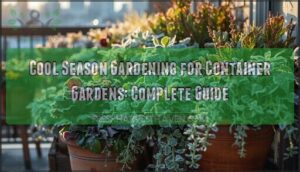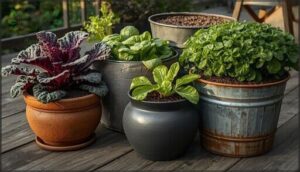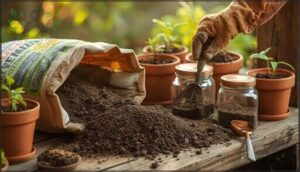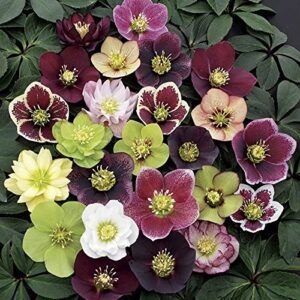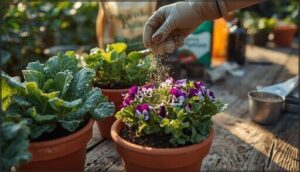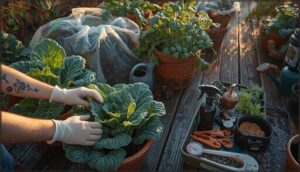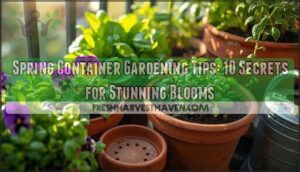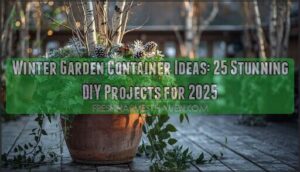This site is supported by our readers. We may earn a commission, at no cost to you, if you purchase through links.
While most gardeners pack away their tools when temperatures drop, container gardeners know that cool weather opens up a whole new growing season. Between 40°F and 70°F, certain plants hit their stride, producing tender greens, vibrant flowers, and crisp vegetables that taste better after a light frost.
Cool season gardening for container gardens transforms patios and balconies into productive spaces during fall and winter months. The trick isn’t just picking cold-hardy plants—it’s understanding how containers change the game.
From choosing materials that protect roots during temperature swings to spacing plants for maximum yield in limited soil, container growing requires different strategies than traditional beds. Get these fundamentals right, and you’ll harvest fresh salads while your neighbors scrape frost off their windshields.
Table Of Contents
- Key Takeaways
- What Are Cool-Season Container Plants
- Choosing Containers for Cool-Season Gardens
- Selecting Potting Mix and Soil Amendments
- Planning Your Cool-Season Planting Schedule
- Top Cool-Season Plants for Containers
- Planting and Spacing in Containers
- Watering and Moisture Management
- Fertilizing Cool-Season Container Gardens
- Designing Attractive Fall and Winter Containers
- Maintaining and Troubleshooting Container Gardens
- Frequently Asked Questions (FAQs)
- Conclusion
Key Takeaways
- Cool-season plants thrive in 40-70°F temperatures and actually improve in flavor after light frost, making fall and winter productive growing periods when most gardens sit dormant.
- Container materials and sizing directly impact plant survival—roots need insulation from temperature swings, proper drainage to prevent the 75% failure rate from waterlogging, and adequate depth (6-12 inches depending on crop type).
- Success hinges on timing your plantings around frost dates (10-12 weeks before last spring frost indoors, 6-8 weeks before first fall frost outdoors) and choosing plants hardy to two zones colder than your actual zone since containers freeze faster than ground soil.
- The thriller-filler-spiller design method (one tall centerpiece, 3-5 mid-height plants, 2-4 trailing edge plants) delivers 40% more foliage density and 15% better plant survival compared to single-species containers.
What Are Cool-Season Container Plants
Cool-season plants are your gardening allies when temperatures drop between 40-70°F. Unlike their heat-loving cousins, these hardy varieties actually prefer chilly weather and can handle a light frost without batting an eye.
Let’s break down what makes a plant “cool-season” and explore which varieties work best in containers.
Defining Cool-Season Plants
Cool-season plants thrive when temperatures hover between 40°F and 70°F, making them perfect for spring and fall cool-season container gardens. They show impressive frost resistance, tolerating light freezes that would damage warm-weather crops. These plants grow best when soil temperature stays around 68°F.
Understanding cool-season plants means recognizing their growth characteristics—they flourish in chilly weather, then slow down or bolt when summer heat arrives. You’ll master cool-season plant selection by focusing on their temperature tolerance and matching planting seasons to your local climate. Consider adding ornamental kale for a splash of color.
Popular Cool-Season Vegetables and Herbs
Once you know which plants tolerate cold, you can stock your containers with practical choices. Leafy green choices like lettuce and spinach produce quickly in shallow pots. Root vegetable options such as carrots and radishes handle frost well.
Herb container varieties worth trying include:
- Culinary sage survives freezing temperatures
- Cilantro thrives in cool months
- Red Giant mustard and Asian green growth mature fast
Many vegetables and herbs for containers develop better flavor after frost, especially kale and Brussels sprouts. Good soil quality is crucial for healthy plant development.
Cool-Season Flowering and Foliage Plants
Beyond edibles, cool-season flowering plants and colorful foliage in containers bring life to chilly months. Mums offer 8–10 weeks of bloom duration, while pansies—annuals for fall and winter—bloom up to 16 weeks across hardiness zones 6–10.
Perennials for containers like coral bells maintain over 90% foliage survival through zone-appropriate winters. Temperature tolerance matters: stonecrop survives -11°F, making seasonal display possible even in harsh conditions.
Choosing Containers for Cool-Season Gardens
The container you choose affects everything from root health to how often you’ll need to water. Different materials offer trade-offs in weight, insulation, and cost that matter when temperatures drop.
Let’s look at the main options and what makes each one work for cool-season growing.
Best Container Materials (Terracotta, Plastic, Fabric)
Your choice of container material shapes how your cool-season plants will perform. Terracotta pots offer excellent material insulation and natural moisture retention through their porous walls, but they’re prone to cracking in freezing weather.
Plastic containers provide durability analysis winners—they’re lightweight containers that resist cold damage.
Fabric grow bags encourage healthy root growth through better drainage hole function, though they dry faster than traditional pots.
Ideal Container Sizes and Depths
The right container size determines whether your cool-season crops thrive or struggle. Shallow-rooted vegetables like lettuce and radishes need at least 6 to 8 inches of depth, while carrots require 10 to 12 inches for proper taproot development. Depth requirements directly affect watering frequency and root rot risk through soil drainage capacity.
- Volume guidelines: Leafy greens grow well in 1 to 3 gallon containers, while cabbage needs 8 to 10 gallons
- Diameter impacts: Small crops succeed in 6 to 8-inch pots; peppers require 12 to 16 inches
- Mixed plantings: Allocate 2 gallons per plant in shared containers for healthy container garden design
Drainage and Mobility Considerations
Without proper drainage holes, even the best potting mix becomes waterlogged and suffocates roots. At least one hole at your container’s base prevents root rot, which causes up to 75% of container plant failures during cooler months.
Mobility matters too—lightweight containers on wheeled caddies let you chase sunlight or dodge frost without straining your back.
Selecting Potting Mix and Soil Amendments
Your container soil matters more than you might think. Regular garden dirt won’t cut it—you need a mix that drains well, holds enough moisture, and gives roots room to breathe.
Let’s walk through what makes good potting mix, how to boost it with the right amendments, and ways to protect your soil when temperatures drop.
Qualities of Good Potting Mix
Your potting mix is the foundation of healthy container plants. Look for these four qualities:
- Aeration porosity between 10% and 30% keeps roots breathing while preventing compaction
- Water retention around 45% to 65% by volume balances moisture without causing root rot
- pH levels from 6.0 to 7.0 support nutrient uptake for most cool-season crops
- Bulk density between 0.19 and 0.70 g/cm³ ensures proper soil structure
Adding Fertilizers and Soil Conditioners
Container gardens need a nutrition boost from the start. Mix controlled-release granular fertilizer into your potting mix before planting to establish steady nutrient cycling. For organic amendments, add compost at about 5 pounds per cubic yard to improve microbial balance and soil health.
These soil conditioning practices support strong roots and vigorous growth throughout the cool season, building organic matter that feeds your plants gradually.
Mulch and Soil Insulation Techniques
Think of mulch as a winter coat for your container plants. A 2- to 4-inch layer moderates soil temperature swings, keeping roots safe from frost damage while cutting moisture loss by up to 30%.
- Shredded bark or straw provides excellent insulation materials for cool-season containers
- Bubble wrap around pots adds extra root protection during hard freezes
- Pine needles decompose slowly, adding organic matter while regulating temperature
- Clustered containers share warmth, reducing cold exposure
- South-facing walls capture passive solar heat for better temperature regulation
Planning Your Cool-Season Planting Schedule
Timing makes all the difference in cool-season container gardening. Plant too early and your seedlings might struggle in lingering heat, but wait too long and they won’t establish strong roots before winter.
Let’s break down the key timing factors that’ll help you plan a schedule that works for your location and goals.
Timing for Spring and Fall Planting
Getting your timing right separates thriving cool-season container gardens from disappointing ones. Start seeds indoors 10 to 12 weeks before your last spring frost date, then move containers outdoors when nights stay above 30°F. For fall container gardening, plant 6 to 8 weeks before the first frost.
| Season | Indoor Start | Outdoor Planting |
|---|---|---|
| Spring | 10-12 weeks before last frost | When nights reach 30°F |
| Fall | Not usually needed | 6-8 weeks before first frost |
| Extended Season | Year-round options | Use protective covers |
Soil temperature monitoring helps you succeed—aim for a minimum of 40°F. Regional planting variations matter greatly; northern climates start late February through March, while southern areas begin in January. Extending the growing season becomes easier when you can relocate containers to protected spots during cold snaps.
Understanding Planting Zones
Your USDA hardiness zone tells you which plants can survive winter in your area, but container considerations change the rules. Choose plants hardy to at least two zones colder than yours—if you’re in Zone 7, select Zone 5 plants. Containers freeze faster than ground soil, exposing roots to harsher conditions.
Microclimate impact matters too; sheltered spots near walls offer extra protection against regional variation and climate change effects.
Succession Planting for Extended Harvests
After understanding zones, succession planting lets you harvest continuously instead of all at once. Plant small batches of cool-season plants every two weeks—your container keeps producing fresh greens for months. This crop rotation approach delivers continuous yield while extending your season by 3-6 weeks and reducing pest problems:
- Calculate your last planting date using frost dates plus maturity time
- Replenish soil between plantings with organic fertilizer
- Try intercropping fast lettuce with slower kale
- Use harvest scheduling to optimize limited container space
Top Cool-Season Plants for Containers
You’ve got your containers and soil ready—now it’s time to pick the plants that’ll actually thrive in cooler weather. The right choices make all the difference between a container that limps along and one that truly performs through fall and early spring.
Here are four reliable options that handle the chill like champs and look great doing it.
1. Pack 3 Mix Mum Plants
Chrysanthemums bring vibrant color to your fall container plantings when other blooms fade. Pack 3 Mix Mum Plants grow 12 to 24 inches tall, thriving in full sun with consistent moisture.
You’ll find varieties like Autumn Sunset and Flamingo Pink in these mixes, chosen to bloom simultaneously for cohesive garden decorations.
For container arrangements, place three plants in a 16-inch urn with 8-inch spacing. These cool-season flowering plants tolerate light frosts and attract butterflies while deer avoid their aromatic foliage, making mum plant care straightforward for fall bloomers.
2. Live Healthy Flowering Pansies Assorted Colors
Pansies pack a punch in fall container plantings, blooming happily when temperatures hover between 40°F and 60°F. These cool-season flowering plants grow 6 to 9 inches tall, spreading up to 12 inches in containers at least 8 inches deep with drainage holes.
You’ll need full sun to partial shade and slightly acidic soil for best results. Pansy fertilization with balanced nutrients at 150 ppm encourages vigorous growth, while deadheading spent blooms extends flowering through winter.
Their edible flowers add color varieties from white to violet, and winter protection methods like frost cloths keep them thriving when temperatures drop.
3. Mixed Lenten Rose Hellebore Fall Plants
Lenten Rose hellebore varieties deliver winter interest when most container garden plant combinations fade, blooming from late winter through May with flowers lasting six weeks or more. You’ll need containers at least 12 inches deep with excellent drainage, as these cool-season plants develop extensive downward roots.
Plant varieties like ‘Ivory Prince’ or ‘Pink Frost’ in partial shade using rich, organic potting soil.
Fall container gardens benefit from hellebore care that includes positioning containers to showcase downward-facing fall blooms, creating striking container design with evergreen foliage year-round in zones 4-9.
4. Autumn Joy Sedum Stonecrop Groundcover Plant
With seasonal color that transitions from bright pink to rosy copper through fall, Autumn Joy Sedum Stonecrop brings multi-season appeal to cool-season container plants. You’ll appreciate its drought tolerance once established, though containers require moderate watering.
Plant this groundcover in well-drained potting mix with full sun, spacing 18 inches apart in fall container garden combinations. Propagation methods include division every 3-4 years.
Maintenance tips are simple: leave seed heads for winter interest, remove them in spring for fresh growth, and pair with ornamental grasses for striking container combinations.
Planting and Spacing in Containers
Getting your plants in the ground is just the beginning—how you space them determines whether they’ll thrive or struggle. Crowded containers lead to stunted growth and disease, while proper spacing ensures each plant gets the air, light, and nutrients it needs.
Let’s look at the spacing strategies that’ll help you make the most of every inch.
Spacing Guidelines for Common Plants
Getting spacing right in your containers feels like solving a puzzle—you want every plant to thrive without stepping on each other’s toes. Root development and air circulation both depend on proper distances between plants.
Leafy greens need 10 to 12 inches to prevent disease, while carrots require just 3 to 4 inches. Smart spacing maximizes yield optimization and minimizes plant competition in your container gardening setup.
Companion Planting Strategies
Pairing the right cool-season plants transforms your container gardening setup into a natural support system. Companion planting strategies combine pest deterrence with nutrient sharing—kale thrives alongside sage, which repels cabbage moths, while nasturtiums draw aphids away.
This biodiversity boost creates space optimization through companion rotation: deep carrots anchor vertical peas, and nitrogen-fixing legumes feed hungry spinach. Your cool-season container garden becomes smarter, not bigger.
Maximizing Yield in Limited Space
Small spaces don’t limit production—they demand smarter techniques. Succession planting rotates fast-maturing crops like radishes into the same soil that held lettuce weeks earlier, boosting productivity 20-50%. Vertical gardening methods stack crops upward, while tight crop density balances individual plant size against total container yield.
- Space leafy greens nearly touching for microgreen harvests, roots 3 cm apart
- Layer vertical gardens using wall pockets or trellises for 30-40% more yield
- Time succession plantings around frost dates—cool-season then warm-season crops
- Thin seedlings post-germination to improve plant spacing and root competition
- Apply nutrient management strategies with slow-release fertilizers for sustained growth
Watering and Moisture Management
Watering container gardens isn’t as simple as just adding water when you remember. Cool-season plants have different moisture needs than summer crops, and containers dry out faster than in-ground beds.
Let’s look at how to keep your plants hydrated without drowning them.
How Often to Water Cool-Season Plants
Your watering schedule depends on weather, plant size, and container type. In cool weather, water once or twice weekly; during hot, windy conditions, you’ll need to water daily or even twice a day.
Check soil moisture by feeling 1 to 2 inches below the surface—if it’s dry, it’s time to water. Always water until it flows from drainage holes.
Signs of Overwatering and Underwatering
Both overwatering and underwatering cause wilting, which makes diagnosis tricky. Check soil moisture first—soggy soil plus droopy leaves points to root rot from too much water. Dry soil with wilting means you’re underwatering.
Overwatered plants show yellow, limp leaves and moldy soil, while underwatered ones display crispy, brown edges and slow growth.
Proper drainage and consistent watering frequency prevent both problems.
Using Mulch to Retain Moisture
Mulching container gardens cuts watering by about 30%. Apply one to two inches of shredded bark, coconut coir, or straw on top of your potting mix, leaving a one-inch gap around plant stems.
This seasonal mulch insulates roots during fall and winter plant care while reducing evaporation. Studies show mulched containers retain 35% more moisture over six weeks, giving you solid moisture retention without constant watering.
Fertilizing Cool-Season Container Gardens
Cool-season container plants have different nutritional needs than their warm-season counterparts, and the confined space of a pot means nutrients get depleted faster. Getting your fertilizer strategy right makes the difference between lackluster growth and a thriving container garden.
Let’s look at how to choose, apply, and decide between organic and synthetic fertilizers for your cool-season plants.
Choosing The Right Fertilizer
You’ll need fertilizer NPK ratios that match your plants’ appetite—cool-season greens thrive on balanced formulas like 1:2:1. Consider these options when fertilizing container plants:
- Water-soluble fertilizer for quick nutrient uptake in tight root spaces
- Slow-release options that feed gradually with each watering
- Organic fertilizer benefits including healthier soil structure
- Lower-concentration organics to minimize over-fertilization risks
- Specialized blends emphasizing nitrogen for leafy growth
Application Frequency and Techniques
Fertilizing your container garden every 2 to 3 weeks keeps plants fed, though slow-release methods cut down the frequency. Liquid application works best as a morning soil drench when temperatures stay below 80°F—never apply to dry soil. Volume adjustments matter since containers need higher rates than ground beds.
Watering leaches nutrients fast, so supplemental irrigation paired with consistent plant care prevents deficiencies. Environmental impact stays low when you follow label rates and watch for runoff.
Organic Vs. Synthetic Options
Between organic and synthetic fertilizers, your choice shapes nutrient release speed, soil health, and long-term garden costs. Here’s what separates them:
- Organic releases nutrients slowly over four to five weeks; synthetic works in days.
- Yield comparison shows organic containers produce 24–33% less but earn 68% higher revenue through premium pricing.
- Microbial health improves 25–40% with organic amendments.
- Environmental impact includes 41% lower nitrous oxide with organics.
- Cost analysis reveals organics need double the volume but avoid salt buildup and pH level swings.
Designing Attractive Fall and Winter Containers
You don’t need to settle for dull containers just because temperatures drop. A few smart design choices can turn your cool-season garden into something that catches the eye from across the yard.
Here’s how to build containers that look intentional and pulled-together through fall and winter.
Using The Thriller, Spiller, Filler Method
The thriller, spiller, and filler method gives your cool-season container plants a balanced look that works every time. Place one tall thriller at the center, then surround it with three to five mid-height fillers, and finish with two to four trailing spillers along the edge. This proven arrangement boosts plant survival by 15% and delivers 40% more foliage density than single-species plantings.
| Plant Type | Role | Examples |
|---|---|---|
| Thriller | Tall centerpiece for vertical interest | Dwarf conifers, flowering kale |
| Filler | Mid-height plants filling space | Pansies, violas, ornamental cabbage |
| Spiller | Trailing plants cascading over edge | Trailing ivy, creeping jenny, sedum |
| Design Ratios | Recommended counts per 16–20 inch container | 1 thriller, 3–5 fillers, 2–4 spillers |
Position your thriller 1.5 to 2 times the container’s height for the best visual impact. Offset placement creates lively asymmetry, preferred in 62% of landscape design surveys. Using odd-numbered groupings increases satisfaction ratings by 18%. This container garden design approach appears in 72% of published fall displays because it delivers reliable results with minimal guesswork.
Position thrillers at 1.5–2x container height, use offset placement and odd groupings—this design formula appears in 72% of published fall displays
Combining Colors, Textures, and Heights
Pairing complementary colors like purple kale and orange pansies strengthens visual impact, while layering three distinct foliage textures creates depth you can see from across the yard.
Use a color wheel to select analogous hues, then balance blooms with at least 60% foliage for steady interest.
Limiting your palette to three to six varieties keeps composition principles sharp and container design unified.
Incorporating Fragrant and Edible Plants
Fragrant plants like sweet alyssum and dianthus transform containers into sensory experiences, while edible herbs deliver fresh flavor steps from your door. Position rosemary or winter honeysuckle where you’ll brush past them daily, releasing aromatic compounds that lift your mood. Meyer lemon adds fragrance plus fruit in full sun.
- Choose culinary herbs such as thyme for compact coolseason container plants rich in flavor
- Layer snapdragons above trailing sweet alyssum to combine height with continuous scent
- Select edibles like kale offering nutritional profiles high in fiber and antioxidants
Maintaining and Troubleshooting Container Gardens
Even well-designed containers need regular attention to stay productive through the season. You’ll face challenges like pests, winter cold snaps, and plants that wear out their welcome.
Here’s how to keep your cool-season containers thriving and fix problems before they derail your garden.
Pest and Disease Monitoring
Check your plants weekly for signs of trouble. Pest identification starts with looking under leaves for aphids, cabbage worms, or spider mites.
Disease prevention means proper spacing and base watering to avoid fungal issues. IPM strategies combine monitoring frequency with natural predators like ladybugs.
For pest and disease management, use organic pest control like neem oil or Bacillus thuringiensis when problems arise.
Overwintering and Protecting Plants
Container plants face root freeze damage when temperatures drop, since roots are less hardy than foliage. You’ll need insulation methods like mulching with straw or sinking pots into the ground for climate protection. Grouping containers together reduces desiccation risks from wind exposure.
Overwintering cool-season plants requires frost protection through covers or windbreaks. Proper container garden maintenance boosts survival rates considerably during cold snaps.
Refreshing and Rotating Plantings
Beyond protecting plants through winter, you’ll want to refresh containers every 6 to 8 weeks to maintain vigor. Rotation benefits include up to 40% higher yields and 73% fewer disease problems.
Remove spent plants, replace tired soil with fresh potting mix, and rotate plant families—brassicas to legumes to nightshades.
This succession planting approach keeps your cool-season container plants productive while preventing nutrient depletion and pest buildup.
Frequently Asked Questions (FAQs)
Can I reuse potting soil from previous seasons?
You can reuse potting mix, but nutrient depletion and disease risks demand attention.
Revitalization techniques—adding fertilizer, amending soil—extend its life.
Most mixes work well for three years before reuse limits appear.
How do I protect containers from freezing temperatures?
Like wrapping yourself in layers before winter’s bite, your pots need protection too. Container insulation using bubble wrap or burlap shields roots, while elevating containers off frozen ground prevents cracking and promotes drainage.
What are the best companion plants for shade?
Shade plant pairings like hostas with astilbes create foliage texture contrast and moisture matching.
For cool-season container garden success on shady porches, companion planting ferns with heuchera maximizes understory biodiversity and limited sunlight productivity.
Should I prune cool-season plants during growth?
Think of pruning as a controlled nudge rather than a full reset. Light trimming every 2-4 weeks promotes bushier growth and better yields, but avoid heavy cuts in late summer or fall to protect cold tolerance.
How do I transition containers from fall to spring?
Start by clearing spent fall plants while keeping evergreen container plants for winter structure. Refresh soil with compost, group pots for winter protection, then replant 6-8 weeks before spring’s last frost.
Conclusion
Picture frost-kissed kale leaves glistening on your balcony while neighbors scrape ice from empty flower beds. That’s the quiet victory of cool season gardening for container gardens.
You’ve learned the fundamentals—proper containers, timing, spacing, and care—that turn cold months into harvest time. Now your patio becomes a productive refuge when most gardens sleep.
The seeds you plant today will reward you with fresh greens, vibrant blooms, and the satisfaction of outsmarting winter itself.
- http://mailto:hgic
- https://goto.walmart.com/c/1943169/568844/9383?subId1=gardeningknowhow-us-1035042402565969451&sharedId=gardeningknowhow-us&u=https%3A%2F%2Fwww.walmart.com%2Fip%2FExpert-Gardener-2-5QT-Ornamental-Purple-Kale-3-Pack-with-Grower-Pots%2F1994849363
- https://njaes.rutgers.edu/fs528/
- https://www.gardeningknowhow.com/special/containers/cool-season-container-plants
- https://extension.sdstate.edu/cool-season-flowering-annuals-garden

